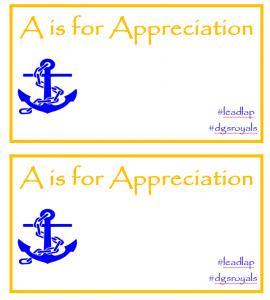Great Learning Comes from Happy Teachers. Happy Teachers Come from DGS!
In the early 2000s, an ad campaign was launched that suggested, “Great cheese comes from Happy Cows. Happy Cows come from California.” In a happenstance conversation with a former staff member, we began talking about this slogan. Although we live in Illinois, she is from Wisconsin and dairy, cheese, and cows are items that came up in our conversation when we discussed her Thanksgiving Break. What was interesting was an immediate connection we made to school culture, teacher performance, and student engagement. We can spin the slogan to say, “Great Learning Comes from Happy Teachers. Happy Teachers Come from DGS!”
Establishing a school culture that promotes teacher engagement and satisfaction rests on some basic tenants of school leadership:
- Administrators need to remember what it was like to sit on the other side of the desk. I was told this by a veteran educator that had served on his community’s Board of Education as well. This advice came the week I accepted my first principalship. His advice has always focused my interactions and approach with staff. As principals, we are teachers first and must consistently remember what it is like to be a teacher.
- Staff norms that are collaboratively development, monitored, and celebrated are the core to staff interactions and efforts. Our staff norms are focused and intentional mutually agreed commitments. They are displayed in common work areas, celebrated in weekly communications to staff in our Friday Focus, and the start to our leadership and faculty meetings. An area in the teacher’s work room provides an opportunity for teachers to use post-its to share examples of their colleagues modeling these norms.

- Principals should model taking risks and support staff that do. I am not talking about jumping out of an airplane or bungee jumping off of a bridge; I would never be able to model that kind of risk taking. I am referring to professional educational risks that push learning in the classroom and foster creativity and innovation. This may include trying a new strategy or lesson, using a different app or technology device, or thinking outside the box regarding an approach to classroom management. Some of the best memories our students will have in school are those times when teachers stepped outside their comfort zone and tried something new or did something unconventional. In order for this to happen, teachers need to feel secure in knowing their attempts in learning will be encouraged, supported, and celebrated. After all, we are modeling lifelong learning for our students and the notion that the word FAIL can represent “a first attempt in learning.”
- Recognition and Support go a long way in validating teachers in their work and interactions with students and families. As adults, we are motivated on positive affirmations and validation of our work. Just as our students benefit from positive praise, teachers do to. Recognition can be both formal and informal. Some examples include:
- Dropping anchors of appreciation during classroom visits. You can read more about this at https://dunlapgradeschool.edublogs.org/2015/10/20/a-is-for-appreciation-challenge-accepted/

- Noticing the Impact of instructional practices on student learning. https://dunlapgradeschool.edublogs.org/2015/10/26/n-is-for-noticing-challenge-accepted/

- Shouting out in the staff weekly memo to those individuals that have gone above and beyond in their job or have implemented an effective or meaningful instructional practice.
- Maintaining an open door for teachers to share their ideas and celebrate their successes!
- For students, recognition includes a Royal of the Month, Positive Office Referrals, Student Shout Outs, Recognition Stickers, and more!
- Nominating teachers for formal awards, grants, and recognition or encouraging staff to nominate their peers
- http://blogs.dunlapcusd.net/d323/2015/11/27/dunlap-grade-school-3rd-grade-teacher-team-named-distinguished-educators-of-the-year/
- http://blogs.dunlapcusd.net/d323/2015/10/28/dgs-2nd-grade-teacher-mrs-pitzer-accepts-state-teaching-award/
- http://www.cinewsnow.com/features/one-class/Classroom-uses-exercise-balls-to-aid-learning–235455891.ht
- http://blogs.dunlapcusd.net/d323/2014/11/04/dunlap-grade-school-teacher-earns-community-award
- Hiring and Mentoring practices that support ongoing learning. The core to any positive staff culture is the hiring of the right individuals that will contribute to their culture and teaching environment. Hiring practices that include the teachers or staff members that will work directly with the new hire can improve collaboration and offer voice to current staff members and give a glimpse into culture for the potential new hire. I make it clear in interviews the expectation of collaboration, communication, and positive interactions. This sets the tone that it is something that is part of being a DGS Royal.
- A school that is student focused and accepts responsibility for all learners. As I write this, I really should place this at the top of the list. To foster a positive school culture, this tenant is paramount. The adults in the building need to accept ownership for all learners, not just the one in their classes or supervision. Learning is a process and doesn’t stop when a child leaves a classroom or grade level. Staff that accept this promote a student first approach and work collaboratively to support all student learning.
This reflection does not discredit the fact that there are challenges, moments of frustration, or bouts of tension. To move forward and grow there are stumbling points and growing pains. The bumps are what we climb on. What does matter is that teachers feel supported by their leadership and each other to weather the storms and look for the rainbows. After all, Happy Teachers make Happy Kids.


